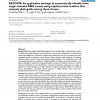1636 search results - page 11 / 328 » Detecting similar software applications |
AIRWEB
2006
Springer
14 years 9 days ago
2006
Springer
Automatically generated content is ubiquitous in the web: dynamic sites built using the three-tier paradigm are good examples (e.g. commercial sites, blogs and other sites powered...
AVI
2006
13 years 10 months ago
2006
Since several years, ubiquitous computing and pervasive computing has emerged and, in particular, context-aware computing. Using mobile devices, the context is perpetually evolvin...
GECCO
2007
Springer
14 years 13 days ago
2007
Springer
We have developed a technique to characterize software developers' styles using a set of source code metrics. This style fingerprint can be used to identify the likely author...
OOPSLA
2005
Springer
14 years 2 months ago
2005
Springer
Code clones in software increase maintenance cost and lower software quality. We have devised a new algorithm to detect duplicated parts of source code in large software. Our algo...
BMCBI
2007
13 years 8 months ago
2007
Background: Most single stranded RNA (ssRNA) viruses mutate rapidly to generate large number of strains having highly divergent capsid sequences. Accurate strain recognition in un...

